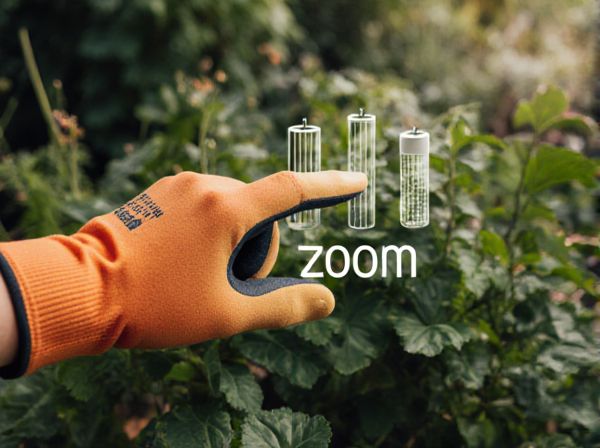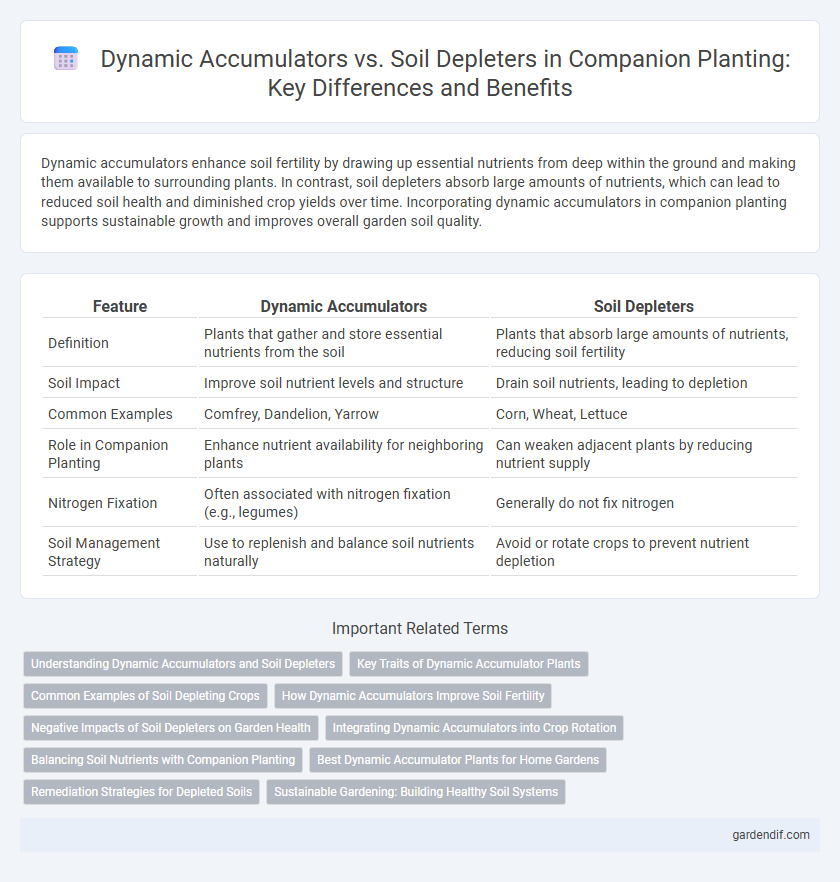
Dynamic accumulators vs Soil depleters Illustration
Dynamic accumulators enhance soil fertility by drawing up essential nutrients from deep within the ground and making them available to surrounding plants. In contrast, soil depleters absorb large amounts of nutrients, which can lead to reduced soil health and diminished crop yields over time. Incorporating dynamic accumulators in companion planting supports sustainable growth and improves overall garden soil quality.
Table of Comparison
| Feature | Dynamic Accumulators | Soil Depleters |
|---|---|---|
| Definition | Plants that gather and store essential nutrients from the soil | Plants that absorb large amounts of nutrients, reducing soil fertility |
| Soil Impact | Improve soil nutrient levels and structure | Drain soil nutrients, leading to depletion |
| Common Examples | Comfrey, Dandelion, Yarrow | Corn, Wheat, Lettuce |
| Role in Companion Planting | Enhance nutrient availability for neighboring plants | Can weaken adjacent plants by reducing nutrient supply |
| Nitrogen Fixation | Often associated with nitrogen fixation (e.g., legumes) | Generally do not fix nitrogen |
| Soil Management Strategy | Use to replenish and balance soil nutrients naturally | Avoid or rotate crops to prevent nutrient depletion |
Understanding Dynamic Accumulators and Soil Depleters
Dynamic accumulators, such as comfrey and nettle, enhance soil fertility by mining deep nutrients and concentrating them in their leaves for compost or mulch, enriching the garden ecosystem. Soil depleters like corn and lettuce extract essential nutrients rapidly, often leading to soil exhaustion if not managed with crop rotation or supplementation. Recognizing the nutrient cycling patterns of these plants supports sustainable gardening by balancing nutrient removal and replenishment.
Key Traits of Dynamic Accumulator Plants
Dynamic accumulator plants possess deep root systems that extract essential nutrients like nitrogen, phosphorus, and potassium from subsoil layers, enriching the topsoil when their biomass decomposes. These plants often have the ability to fix atmospheric nitrogen, improving soil fertility without synthetic fertilizers. Key traits include rapid nutrient uptake, high biomass production, and compatibility with companion planting to naturally replenish depleted soils.
Common Examples of Soil Depleting Crops
Common examples of soil depleting crops include corn, wheat, and cotton, which extract high levels of nitrogen, phosphorus, and potassium from the soil, leading to nutrient imbalance and reduced fertility. These crops often require intensive fertilization and irrigation, increasing the risk of soil degradation and erosion. Avoiding monoculture of these plants and integrating dynamic accumulators like legumes can help restore soil nutrients and promote sustainable soil health.
How Dynamic Accumulators Improve Soil Fertility
Dynamic accumulators enhance soil fertility by drawing up essential nutrients like nitrogen, potassium, and phosphorus from deep soil layers and storing them in their leaves, which decompose to enrich the topsoil. Plants such as comfrey, nettle, and dandelion act as natural biofertilizers, improving nutrient cycling and increasing organic matter content. This process reduces the need for synthetic fertilizers and supports healthier, more sustainable companion planting systems.
Negative Impacts of Soil Depleters on Garden Health
Soil depleters, such as corn and potatoes, rapidly exhaust essential nutrients like nitrogen, phosphorus, and potassium, leading to reduced soil fertility and compromised plant growth. Their continuous cultivation can disrupt the soil microbial ecosystem, resulting in diminished organic matter and increased susceptibility to erosion. This deterioration negatively impacts overall garden health by stunting plant development and increasing vulnerability to pests and diseases.
Integrating Dynamic Accumulators into Crop Rotation
Incorporating dynamic accumulators such as comfrey, yarrow, and dandelion into crop rotation enhances soil fertility by concentrating essential nutrients like potassium, phosphorus, and calcium. These plants improve nutrient cycling and reduce dependency on synthetic fertilizers while counteracting the effects of soil depleters like corn and wheat. Strategic integration ensures nutrient-rich biomass is returned to the soil, fostering sustainable and productive agricultural systems.
Balancing Soil Nutrients with Companion Planting
Dynamic accumulators like comfrey and yarrow pull essential nutrients such as potassium and calcium from deep within the soil, making them available to nearby plants and enhancing soil fertility. In contrast, soil depleters such as corn and cabbage rapidly consume key nutrients, often leaving the soil deficient and requiring replenishment. Balancing soil nutrients through strategic companion planting harnesses the nutrient-accumulating properties of dynamic accumulators to support nutrient-demanding soil depleters, promoting sustainable garden health and productivity.
Best Dynamic Accumulator Plants for Home Gardens
Comfrey, yarrow, and stinging nettle rank among the best dynamic accumulator plants for home gardens due to their deep roots that mine essential nutrients like potassium, calcium, and nitrogen from subsoil layers. These plants enrich the topsoil naturally, reducing the need for synthetic fertilizers while improving soil structure and microbial activity. Integrating dynamic accumulators into companion planting schemes enhances soil fertility and supports healthy growth of neighboring crops by minimizing nutrient depletion.
Remediation Strategies for Depleted Soils
Dynamic accumulators, such as comfrey and nettle, enhance soil fertility by sequestering essential nutrients like potassium and nitrogen in their biomass, which can be composted back into the soil to remediate depleted areas. Incorporating these plants in crop rotations or intercropping systems accelerates nutrient recycling and improves soil structure by reducing compaction and increasing organic matter. Targeted use of dynamic accumulators combined with soil amendments like biochar or compost significantly restores nutrient balance and microbial activity in degraded soils.
Sustainable Gardening: Building Healthy Soil Systems
Dynamic accumulators enrich soil by drawing up essential nutrients like nitrogen, phosphorus, and potassium from deep within the earth, making them available to surrounding plants and enhancing soil fertility naturally. Soil depleters, on the other hand, extract key nutrients without replenishing them, leading to nutrient-poor soil that weakens plant growth and ecosystem health. Sustainable gardening practices prioritize the use of dynamic accumulators to build resilient, nutrient-rich soil systems that support long-term productivity and biodiversity.
Dynamic accumulators vs Soil depleters Infographic

 gardendif.com
gardendif.com